Abstract
Aim:
The objective of the study was to determine the neutralizing effect of proanthocyanidin (grape seed extract) and lycopene (tomato extract) on reactive oxygen species (ROS) generated by the mixture when used as an intracanal medicament. The study also evaluated the effect of proanthocyanidin and lycopene on the antibacterial efficacy of a mixture of chlorhexidine (CHX) and calcium hydroxide [Ca(OH)2] against Enterococcus feacalis.
Materials and Methods:
Four sample groups were prepared as follows. Group I: 2% CHX gluconate (control group) and group II: a mixture of 125 mg of Ca(OH)2 with 2% CHX gluconate solution. Group III was a mixture of 125 mg of Ca(OH)2 with 1 mL of 2% CHX gluconate solution and 1 mL of 5% proanthocyanidin solution and group IV, a mixture of 125 mg of Ca(OH)2 with 1 mL of 2% CHX gluconate solution and 1 mL of 5% lycopene solution. The groups were analyzed for ROS formation using the mass spectrometer (JEOL GC MATE II) immediately after preparation. The antibacterial property was evaluated by using agar diffusion method and the results were statistically analyzed using one-way analysis of variance (ANOVA) and Tukey-Kramer multiple comparison tests.
Results:
The peak value of 196.96 denotes ROS formation. Group II shows a higher peak value than other groups. Group IV shows a drastic reduction in the peak value. Group IV shows a drastic reduction in ROS formation when compared with group II, group III, and the control group. Antibacterial efficacy was higher in group IV, followed by group III, group II, and group I.
Conclusion:
Lycopene and proanthocyanidin reduce the ROS significantly by virtue of their antioxidant property. Lycopene shows more antioxidant property when compared with proanthocyanidin.
Keywords: Lycopene, proanthocyanidin, reactive oxygen species, antibacterial efficacy
INTRODUCTION
The primary goal of endodontic therapy is to make the root canal system devoid of micro-organisms. This can be achieved by thorough biomechanical preparation, along with effective debridement and disinfection protocols. The use of various intracanal irrigants and medicaments are essential to control microbial infections especially in the lateral and accessory canals, isthmus, and apical deltas.[1]
Calcium hydroxide [Ca(OH)2] is a commonly employed intracanal medicament in root canal therapy. Its antibacterial activity is directly related to its ionic dissociation into calcium and hydroxyl ions;this high alkalinity inactivates bacterial enzymes. Chlorhexidine (CHX, N,N1-Bis(4-chlorophenyl)-3,12-diimino-2, 4, 11, 13,tetraaza tetradecadediimidamide), a potent antibacterial and antiseptic agent is used extensively in the irrigation of root canal walls and also as a medicament during routine endodontic therapy. It has the ability to maintain antibacterial activity for a prolonged period. A mixture of Ca(OH)2 and CHX has been shown to possess better antimicrobial efficacy due to their synergistic effect than Ca(OH)2 alone.[2] In vitro studies have demonstrated that CHX might induce ROS production in an alkaline environment. The preparation of the Ca(OH)2 and 0.2% CHX mixture generates ROS immediately after the mixture and also after 7 and 14 days.[3] ROS inhibits the growth of Enterococcus feacalis by destruction of its cell wall and plasma membrane and plays an important role in the pathogenesis of pulpal and periodontal diseases.[4,5]
ROS are oxygen-containing, chemically reactive molecules. The high reactivity is mainly due to the presence of unpaired valence shell electrons. During normal metabolism of oxygen, ROS is formed as a byproduct and plays an important role in cell signaling and homeostasis. However, during oxidative stress, ROS levels increase intensely and result in significant damage to cell structures. These species are cytotoxic and have been implicated in the etiology of a wide array of human diseases.[5] Thus ROS can kill bacteria but it also destroys the adjacent infected host tissues.[6]
To counteract the ROS formation, ROS scavengers/antioxidants are of prime importance for preventing and controlling human diseases. Antioxidants are necessary for the destruction of these free radicals (ROS) by reacting with oxygen and thereby preventing the harmful effects caused by oxygen radicals.[3] Proanthocyanidin and lycopene are potent bioactive antioxidants naturally occurring in grape seed and tomato extracts, respectively and act as ROS scavengers.[7,8] Proanthocyanidins are seen in high concentrations in red wine and grapes. They are antibacterial, antiallergic, and inhibit platelet aggregation and capillary permeability; these effects contribute to the potent antioxidant ability.[7] Lycopene, a red pigment found in tomato-based products, is an acyclic form of beta-carotene.[8] It is a highly unsaturated hydrocarbon containing 11 conjugated and two unconjugated double bonds.[9]
No study has been undertaken to comparatively analyze the role of grape seed and tomato extract in reducing ROS formation. Hence the objective of this study was to analyze ROS formation when CHX was mixed with Ca(OH)2 and to evaluate the effect of proanthocyanidin and lycopene on ROS formation when mixed with CHX and Ca(OH)2. The study also aims to evaluate the effect of these antioxidants on the antibacterial efficacy of Ca(OH)2 and CHX against E. feacalis.
MATERIALS AND METHODS
Preparation of solutions
Five grams of grape seed extract (GNC Herbal Plus, Singapore) in the form of powder was collected from capsules and dissolved in 100 mL of distilled water to make 5% proanthocyanidin solution. Five grams of tomato extract (Parry Nutraceuticals, India) in the form of powder was dissolved in 100 mL of distilled water to make 5% lycopene solution.
Preparation of sample
Four sample groups were prepared as follows. Group I: 2% CHX gluconate, (ASEP-RC, Steadman Pharmaceuticals Pvt Ltd, Thiruporur, Tamilnadu), group II was a mixture of 125 mg of Ca(OH)2 with 1 mL of 2% CHX gluconate solution. Group III comprised a mixture of 125 mg of Ca(OH)2 with 1 mL of 2% CHX solution and 1 mL of 5% proanthocyanidin solution and group IV, a mixture of 125 mg of Ca(OH)2 with 1 mL of 2% CHX gluconate solution and 1 mL of 5% lycopene solution. On mixing, groups II, III, and IV had a paste-like consistency.
Evaluating ROS formation
Each of the sample groups was analyzed for ROS formation using the mass spectrometer (JEOL GC MATE II) immediately after preparation. The mass spectrometer was used in the electron impact ionization method with the ion source temperature held at 280°C, detector volts of 70 eV, and a mass range of 50 to 500 amu (amu: atomic mass unit). The output was recorded as peak values on a computer.
Antibacterial assessment
Antibacterial property was evaluated by using agar diffusion method. All the groups were placed on the petri dishes inoculated with Robertson's cooked media and incubated at a temperature of 37±1°C with Muller Hinton agar and were incubated for 24 hours. The agar was evenly distributed over the surfaces of the Petri dishes (of 90 mm diameter) to a thickness of 5 mm. Standard wells with a diameter of 4.0 mm were punched into the agar with the blunt end of a Pasteur pipette. Approximately 0.5 mL suspensions of E. feacalis were swabbed over the surface of the agar plates with a sterile applicator. The agar plates were incubated at 37 °C for 24 hours. The diameters of the inhibition zones around the materials were measured in mm using vernier caliper and divider after 24 hours. The results were tabulated and analyzed statistically using one-way ANOVA and Tukey-Kramer multiple comparison tests.
RESULTS
The graph that shows a peak value of 196.96 denotes ROS. When comparing the Graphs of group I [Figure 1], group II [Figure 2] and group III [Figure 3], the group IV [Figure 4] shows a drastic reduction in ROS formation.
Figure 1.
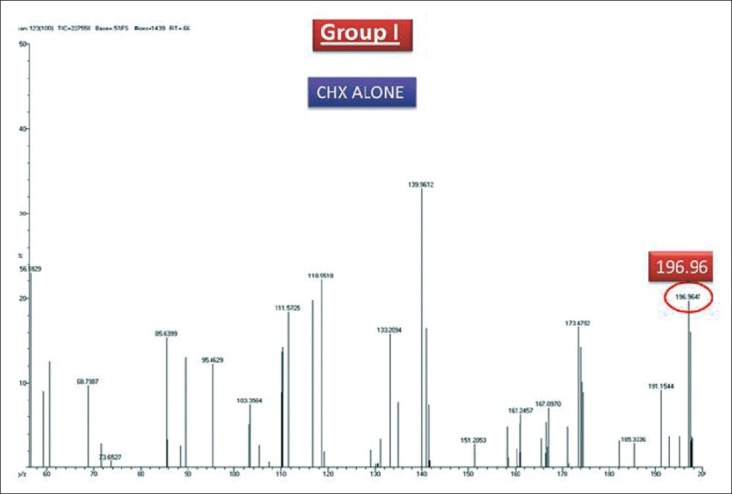
Reactive oxygen species formation in group I
Figure 2.
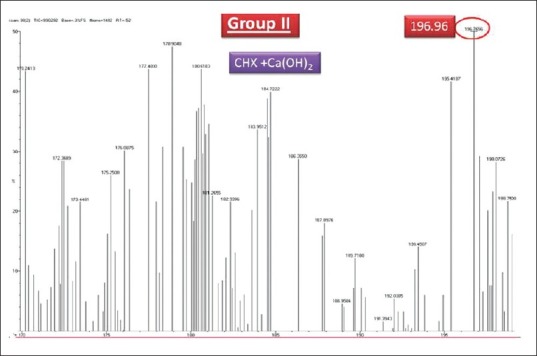
Reactive oxygen species formation in group II
Figure 3.
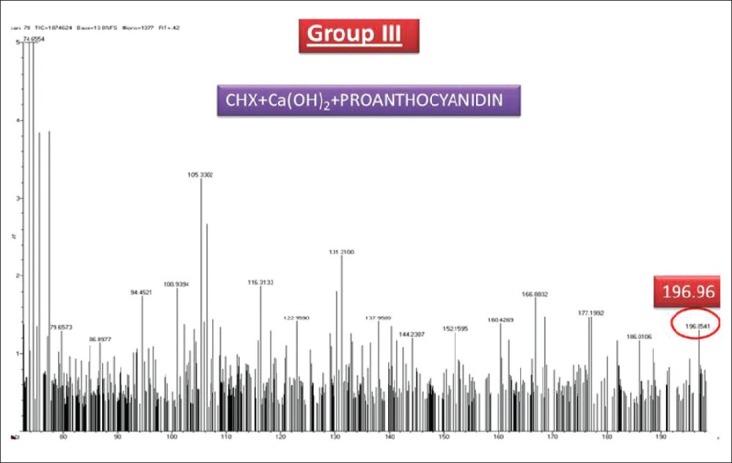
Reactive oxygen species formation in group III
Figure 4.
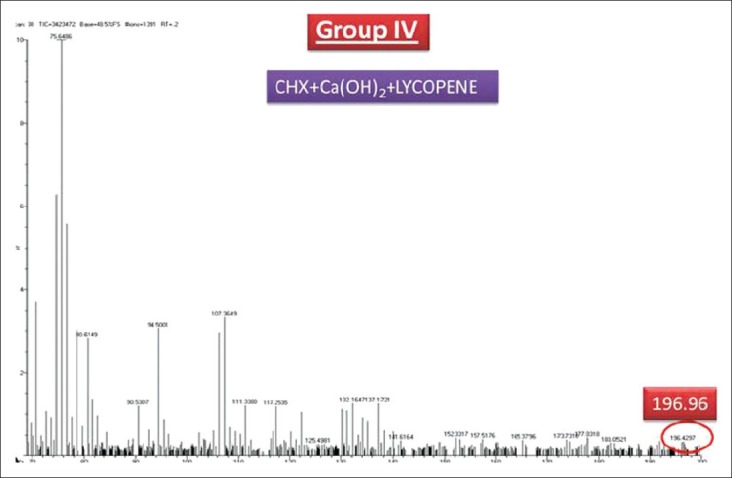
Reactive oxygen species formation in group IV
DISCUSSION
ROS such as superoxide radical, hydrogen peroxide, singlet oxygen, and hydroxyl radical are small, short-lived, and highly reactive molecules formed by incomplete one-electron reduction of oxygen. They are cytotoxic and have been implicated in various diseases like diabetes and neurodegenerative diseases, and influence cellular processes such as proliferation, apoptosis, and senescence, responsible for cancer development. Generally, harmful effects of ROS on the cell most often include damage of DNA, oxidation of polydesaturated fatty acids in lipids, oxidation of amino acids in proteins, and oxidative inactivation of specific enzymes by oxidation of cofactors.[5] However, ROS in lesser quantities are shown to be bactericidal and can enhance cell proliferative activity and information signaling. ROS inactivate bacteria and their proteins and contribute to the microbicidal activity of phagocytes, regulation of signal transduction, and gene expression, and cause oxidative damage to nucleic acids, proteins, and lipids. Waris and Ahsan have reported that elevated levels of ROS and downregulation of ROS scavengers and antioxidant enzymes are associated with various human diseases including different types of cancer. In normal conditions, a dynamic equilibrium exists between ROS activity and defense capacity of antioxidants. The shift in equilibrium in favor of ROS activity results in oxidative stress. This might happen either due to an increase in ROS production or a decrease in defense capacity of antioxidants. Antioxidants are substances which considerably delay or inhibit oxidation of the oxidizable substrate at lower concentrations.[10]
Proanthocyanidins, or condensed tannins, are oligomers and polymers of flavan-3-ols, found in the skin, stems, and seeds of grapes from which they are extracted into the must during vinification.[11] Many in vitro and in vivo studies have shown that proanthocyanidins possess potent antioxidant properties.[12,13] Grape seed extract was chosen for this study as it yields a 10% higher concentration of proanthocyanidins, with a greater degree of oxygen free radical-scavenging potential when compared to skins and stems of grapes.[14] Proanthocyanidin possesses anticariogenic property by inhibiting the glucan synthesis and the subsequent adhesion of Streptococcus mutans on the structure of the tooth. Moreover, grape seed extracts inhibit the growth of anaerobic bacteria, such as Porphyromonas gingivalis and Fusobacterium nucleatum, associated with periodontal diseases.[15]
Lycopene, the red pigment of tomato, is a tetraterpene assembled from eight isoprene units composed entirely of carbon and hydrogen, containing 11 conjugated and two nonconjugated carbon–carbon double bonds.[9] Various studies have shown that the consumption of a lycopene-rich diet reduces the incidence of cancers and heart diseases. Lycopene possesses antibacterial and antifungal properties.[16,17] It is an effective adjuvant in the treatment of gingivitis along with oral prophylaxis.[18] Lycopene exerts potent antifungal activity against Candida albicans by causing significant damage to the cell membrane.[19] Lycopene, the main carotenoid in tomato products along with vitamin C and flavonoids, possesses the greatest quenching ability of singlet oxygen which accounts for its strong antioxidant and free radical-scavenging property.[20] It protects cell membranes from lipid peroxidation by neutralizing hydroxyl radicals and stimulating antioxidative enzymes such as superoxide dismutase, glutathione peroxidase, and glutathione reductase. Lycopene has the potential to quench singlet oxygen, scavenge free radicals of nitrogen dioxide (NO2), thiyl (RS), and sulfonyl (RSO2), which also contributes to its potent antioxidant activity.[21,22]
According to the results of this study, the peak value of 196.96 denotes ROS formation. The peak of 195 m/z was probably originated by the production of reactive compounds (ROS), as a result of the high concentration of hydroxyl ions (alkaline environment) in the presence of CHX. The maximum production of ROS was observed in group II which is reflected in its higher peak value. When compared with group I (CHX), group II [Ca(OH)2+CHX ] shows a higher ROS formation. This is probably due to the formation of hydroxyl ion which is the dissociation product of Ca(OH)2 at an alkaline pH. Group IV [lycopene+CHX+Ca(OH)2] and group III [Ca(OH)2+CHX+proanthocyanidin] show a significant decrease in ROS when compared with group II and group I. The reduction in ROS is attributed to the inherent antioxidant properties found in group IV and group III. Between group IV and group III, group IV shows a drastic reduction in ROS formation in the graph when compared to group III. The reduction in ROS levels in group III could be due to the fact that proanthocyanidins have specificity for hydroxyl free radicals and they possess multiple donor sites enabling them to trap superoxide radicals, and they also undergo redox reactions helping them to scavenge free radicals.[23] Lycopene, by virtue of its high number of conjugated double bonds, has the maximum oxygen-quenching ability. Oxygen quenching by lycopene occurs via physical quenching, that is, the carotenoid remains intact and can undergo further cycles of single oxygen quenching. Further, lycopene is an effective deactivator of electronically excited sensitizer molecules which are involved in the generation of radicals and singlet oxygen.[24] This could account for the drastic reduction of ROS seen in group IV. The relatively low molecular weight of lycopene (536.87 g/mol) when compared with proanthocyanidin (592.54 g/mol) could be also a factor for decreased ROS formation with lycopene. The low molecular weight ensues better penetration and thereby resultant decreased ROS formation.
The antibacterial efficacy of the groups was evaluated to determine whether reduction in ROS formation reduces the antibacterial potential of the extracts, as ROS plays a major role in inactivation of bacterial proteins due to its bactericidal effect. The agar diffusion method was chosen as it is a preliminary and most widely used method for antibacterial assessment. The antibacterial efficacy as evident from Table 1 is as follows:
Table 1.
Zones of inhibition

Group IV > group III > group II > group I. Group IV shows the maximum antibacterial efficacy with a zone of inhibition seen at 27 mm, whereas group I shows the least antibacterial efficacy with the zone of inhibition evident at 15 mm. Group III and group II have zones of inhibition at 23 mm and 20 mm, respectively. Table 2 shows the intergroup comparisons between the four groups. Group I was statistically significant with respect to group III and group IV. Group II was statistically significant with group IV. No statistical difference was observed between groups I and II, groups II and III, and groups III and IV. Hence it can be said that lycopene and proanthocyanidin by their inherent antibacterial properties, produce a greater zone of bacterial inhibition than the CHX group and the Ca(OH)2- CHX mixture group.
Table 2.
Comparison between the four groups
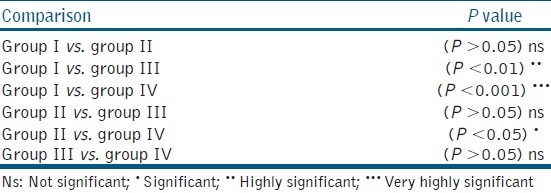
CONCLUSION
Within the limitations of this study, it can be concluded that the combination of Ca(OH)2 and CHX generates excessive amount of ROS which is detrimental to the host tissues. Lycopene and proanthocyanidin reduce the ROS significantly. Lycopene shows more antioxidant property when compared with proanthocyanidin. Addition of natural antioxidants like lycopene and proanthocyanidin to the Ca(OH)2-CHX mixture increases the antibacterial efficacy of the Ca(OH)2-CHX mixture and also decreases damage to the host tissue by lowering ROS formation. Thus, lycopene or proanthocyanidin are effective additives to enhance the antibacterial efficacy and for the safer use of intracanal medicament.
Footnotes
Source of Support: Nil
Conflict of Interest: None declared.
REFERENCES
- 1.Paquette L, Legner M, Fillery ED, Friedman S. Antibacterial efficacy of chlorhexidine gluconate intracanal medication in vivo. J Endod. 2007;33:788–95. doi: 10.1016/j.joen.2005.12.017. [DOI] [PubMed] [Google Scholar]
- 2.Siqueira JF, Jr, Paiva SS, Rôças IN. Reduction in the cultivable bacterial populations ininfected root canals by a chlorhexidine-based antimicrobial protocol. J Endod. 2007;33:541–7. doi: 10.1016/j.joen.2007.01.008. [DOI] [PubMed] [Google Scholar]
- 3.Yeung SY, Huang CS, Chan CP, Lin CP, Lin HN, Lee PH, et al. Antioxidant and pro- oxidant properties of chlorhexidine and its interaction with calcium hydroxide solutions. Int Endod J. 2007;40:837–44. doi: 10.1111/j.1365-2591.2007.01271.x. [DOI] [PubMed] [Google Scholar]
- 4.Nishikawa T, Sato E, Choudhury T, Nagata K, Kasahara E, Matsui H, et al. Effect of nitric oxide on the oxygen metabolism and growth of E. faecalis. J Clin Biochem Nutr. 2009;44:178–84. doi: 10.3164/jcbn.08-235. [DOI] [PMC free article] [PubMed] [Google Scholar]
- 5.Chapple IL. Reactive oxygen species and antioxidants in inflammatory diseases. J Clin Periodontol. 1997;24:287–96. doi: 10.1111/j.1600-051x.1997.tb00760.x. [DOI] [PubMed] [Google Scholar]
- 6.Battino M, Ferreiro MS, Fattorini D, Bullon P. In vitro antioxidant activities of mouth rinses and their components. J Clin Periodontol. 2002;29:462–7. doi: 10.1034/j.1600-051x.2002.290512.x. [DOI] [PubMed] [Google Scholar]
- 7.Aron PM, Kennedy JA. Flavan-3-ols: Nature, occurrence and biological activity. Mol Nutr Food Res. 2008;52:79–104. doi: 10.1002/mnfr.200700137. [DOI] [PubMed] [Google Scholar]
- 8.Agarwal S, Rao AV. Tomato lycopene and low density lipoprotein oxidation: A human dietary intervention study. Lipids. 1998;33:981–4. doi: 10.1007/s11745-998-0295-6. [DOI] [PubMed] [Google Scholar]
- 9.Agarwal S, Rao AV. Tomato lycopene and its role in human health and chronic diseases. Can Med Assoc J. 2000;163:739–44. [PMC free article] [PubMed] [Google Scholar]
- 10.Waris G, Ahsan H. Reactive oxygen species: Role in the development of cancer and various chronic conditions. J Carcinog. 2006;5:14. doi: 10.1186/1477-3163-5-14. [DOI] [PMC free article] [PubMed] [Google Scholar]
- 11.He F, Pan QH, Shi Y, Duan CQ. Chemical synthesis of proanthocyanidins in vitro and their reactions in ageing wines. Molecules. 2008;13:3007–32. doi: 10.3390/molecules13123007. [DOI] [PMC free article] [PubMed] [Google Scholar]
- 12.Raza H, John A. In vitro protection of reactive oxygen species-induced degradation of lipids, proteins and 2-deoxyribose by tea catechins. Food Chem. 2007;45:1814–20. doi: 10.1016/j.fct.2007.03.017. [DOI] [PubMed] [Google Scholar]
- 13.Cirico TL, Omaye ST. Additive or synergetic effects of phenolic compounds on human low density lipoprotein oxidation. Food Chem Toxicol. 2006;44:510–16. doi: 10.1016/j.fct.2005.08.025. [DOI] [PubMed] [Google Scholar]
- 14.Pastrana-Bonilla E, Akoh CC, Sellappan S, Krewer G. Phenolic contentand antioxidant capacity of mascuadine grapes. J Agric Food Chem. 2003;51(18):5497–503. doi: 10.1021/jf030113c. [DOI] [PubMed] [Google Scholar]
- 15.Ferrazzano GF, Amato I, Ingenito A, Zarrelli A, Pinto G, Pollio A. Plant polyphenols and their anti-cariogenic properties: A review. Molecules. 2011;16:1486–507. doi: 10.3390/molecules16021486. [DOI] [PMC free article] [PubMed] [Google Scholar]
- 16.Dahan K, Fennal M, Kumar NB. Lycopene in the prevention of prostate cancer. J Soc Integr Oncol. 2008;6:29–36. [PubMed] [Google Scholar]
- 17.Rao AV. Lycopene, tomatoes, and the prevention of coronary heart disease. Exp Biol Med (Maywood) 2002;227:908–13. doi: 10.1177/153537020222701011. [DOI] [PubMed] [Google Scholar]
- 18.Chandra RV, Prabhuji ML, Roopa DA, Ravirajan S, Kishore HC. Efficacy of lycopene in the treatment of gingivitis: A randomised, placebo-controlled clinical trial. Oral Health Prev Dent. 2007;5:327–36. [PubMed] [Google Scholar]
- 19.Sung WS, Lee IS, Lee DG. Damage to the cytoplasmic membrane and cell death caused by lycopene in Candida albicans. J Microbiol Biotechnol. 2007;17:1797–804. [PubMed] [Google Scholar]
- 20.Di Mascio P, Kaiser S, Sies H. Lycopene as the most efficient biological carotenoid singlet oxygen quencher. Arch Biochem Biophys. 1989;274:532–8. doi: 10.1016/0003-9861(89)90467-0. [DOI] [PubMed] [Google Scholar]
- 21.Subhash K, Bose C, Agrawal BK. Effect of short term supplementation of tomatoes on antioxidant enzymes and lipid peroxidation type-II diabetes. Indian J Clin Biochem. 2007;22:95–8. doi: 10.1007/BF02912889. [DOI] [PMC free article] [PubMed] [Google Scholar]
- 22.Tang X, Yang X, Peng Y, Lin J. Protective effects of lycopene against H2O2- induced oxidative injury and apoptosis in human endothelial cells. Cardiovasc Drugs Ther. 2009;23:439–48. doi: 10.1007/s10557-009-6206-3. [DOI] [PubMed] [Google Scholar]
- 23.Fine AM. Oligomeric proanthocyanidin complexes: History, structure and phytopharmaceutical applications. Altern Med Rev. 2010;5:144–51. [PubMed] [Google Scholar]
- 24.Stahl W, Sies H. Bioactivity and protective effects of natural carotenoids. Biochim Biophysic Acta. 2005;1740:101–7. doi: 10.1016/j.bbadis.2004.12.006. [DOI] [PubMed] [Google Scholar]


